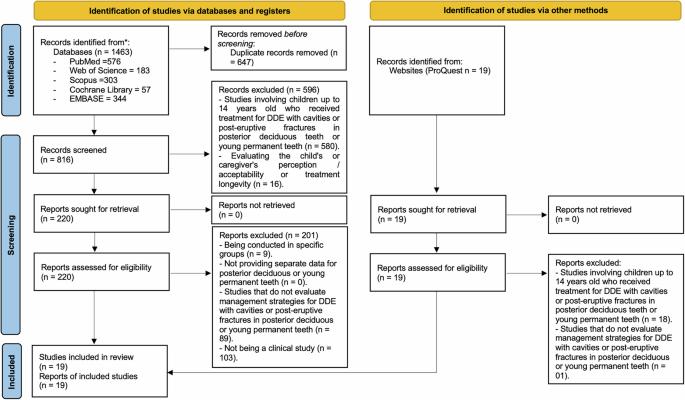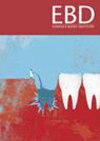后乳牙和恒牙釉质发育缺陷出现出牙后破裂或非典型空化龋齿的处理策略:系统回顾和荟萃分析。
IF 2.3
Q3 Dentistry
引用次数: 0
摘要
目的:本研究旨在评估治疗后乳牙和恒牙釉质发育缺陷(DDE)的不同治疗策略,这些缺陷表现为爆发后破裂或非典型空化龋齿病变,重点是治疗的寿命和父母和儿童对治疗的可接受性/感知。方法:对截至2025年4月9日的电子数据库进行全面检索,以确定14岁以下儿童后乳牙或恒牙DDE治疗方法的临床研究。结果:90项研究符合纳入标准:15项研究集中在磨牙-切牙低矿化(MIH), 1项研究集中在第二初级磨牙低矿化,1项研究集中在釉质发育不全,2项研究涵盖各种类型的DDE。最常用的修复方法包括美学修复和金属冠修复、复合树脂(CR)和玻璃离子水泥(GIC)修复以及复合树脂(ICR)和陶瓷(ICeramics)的间接修复,这些方法已被家长和儿童广泛接受。荟萃分析仅针对与MIH相关的研究。在24个月的随访期间,总成功率为84% (95% CI: 70-99%)。亚组分析没有显示恢复性治疗方案之间的显著差异(p = 0.336)。结论:美冠和金属冠、ICR、ICeramics、CR和GIC可能是治疗MIH和其他类型DDE的可行选择。然而,证据的确定性仍然很低,大多数研究显示出高度或严重的偏倚风险。本文章由计算机程序翻译,如有差异,请以英文原文为准。

Management strategies for posterior deciduous and permanent teeth with developmental defects of enamel presenting post-eruptive breakdown or atypical cavitated carious lesions: systematic review and meta-analysis
This study aimed to evaluate different management strategies for treating posterior deciduous and permanent teeth affected by developmental defects of enamel (DDE) presenting with post-eruptive breakdown or atypical cavitated carious lesions, with a focus on longevity and the acceptability/perception of the treatment by parents and children. A comprehensive search of electronic databases was conducted up to April 09, 2025, to identify clinical studies addressing treatment approaches for posterior deciduous or permanent teeth with DDE in children up to 14 years old. Ninety studies met the inclusion criteria: 15 focused on molar-incisor hypomineralisation (MIH), one on hypomineralised second primary molar, one on amelogenesis imperfecta, and two covering various types of DDE. The most used restorative treatments included aesthetic and metal crowns, composite resin (CR) and glass ionomer cement (GIC) restorations, and indirect restoration with composite resin (ICR) and ceramics (ICeramics), which have been well accepted by both parents and children. Meta-analyses were conducted exclusively on studies related to MIH. Over a 24-month follow-up period, the overall success rate was 84% (95% CI: 70–99%). Subgroup analyses did not indicate significant differences among restorative treatment options (p = 0.336). Aesthetic and metal crowns, ICR, ICeramics, CR, and GIC may be viable treatment options for the management of MIH and other types of DDE. However, the certainty of the evidence remains low, and most studies exhibited a high or critical risk of bias.
求助全文
通过发布文献求助,成功后即可免费获取论文全文。
去求助
来源期刊

Evidence-based dentistry
Dentistry-Dentistry (all)
CiteScore
2.50
自引率
0.00%
发文量
77
期刊介绍:
Evidence-Based Dentistry delivers the best available evidence on the latest developments in oral health. We evaluate the evidence and provide guidance concerning the value of the author''s conclusions. We keep dentistry up to date with new approaches, exploring a wide range of the latest developments through an accessible expert commentary. Original papers and relevant publications are condensed into digestible summaries, drawing attention to the current methods and findings. We are a central resource for the most cutting edge and relevant issues concerning the evidence-based approach in dentistry today. Evidence-Based Dentistry is published by Springer Nature on behalf of the British Dental Association.
 求助内容:
求助内容: 应助结果提醒方式:
应助结果提醒方式:


